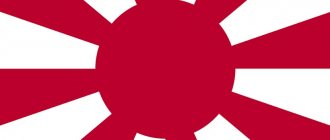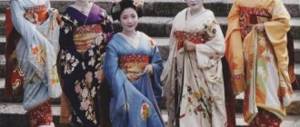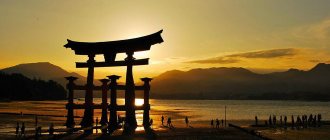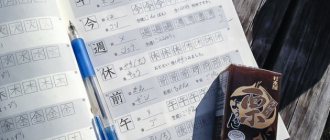Story
The term "kikumon" is made up of two words. “Kiku” means “chrysanthemum” in Japanese.
Mon is the Japanese equivalent of European coats of arms. These are round emblems with a symbolic design. The image could mean the social status of the owner or his belonging to a noble family. Early uses of mon date back to the 8th century. Armorial images were included in the ornament of expensive fabrics and were cut out on the personal seals of the owners.
Kikumon has been a symbol of the Japanese imperial family since the 12th century. The first bearer of the emblem is Emperor Gotoba. The ruler loved chrysanthemums and turned a stylized image of the flower into a personal sign and seal. Gotoba's followers on the throne continued the tradition, and the symbol of this flower was assigned to the ruling dynasty.
In 1869, the imperial status of kikunogomon was officially approved.
During the Meiji period - the "opening" of Japan to the Western world (from the early 1870s) - the right to use the emblem was strictly limited. The 32-petal chrysanthemum belonged exclusively to the emperor.
In 1926, Kikumon first appeared on the covers of Japanese passports.
During World War II, the golden chrysanthemum was a distinctive sign of Japanese ships.
Today, a stylized image of the flower is printed on government papers and personal documents of the Japanese, and minted on coins. The law does not specify the stamp status of the flower.
National flag of Japan
Official name: 日章旗 (nissho:ki) – “national flag” Common name: 日の丸 (hinomaru) – “sun circle” Date of official adoption: August 13, 1999 Colors: white, scarlet
Story.
The history of the flag in Japan goes back more than a thousand years, but at different periods flags/banners/standards were used as signs of authority, symbols of belonging to a particular military unit, and even as signs to attract the attention of customers. But the appearance of the national flag was the result of Japan’s entry into the world community, the desire and need to follow the norms accepted in it.
In 1867, after a long period of self-isolation, the country was opened to the outside world. Almost immediately after this, the need arose to create a symbol to represent the country. In 1870, Article 57 of the “Rules on Merchant Ships” established the mandatory presence of the Hinomaru flag on every ship. And after this, the flag became established as a symbol of the Japanese state.
During World War II, the flag became firmly established as a symbol of imperialist, militaristic Japan. In the countries of East Asia, one type of “sun circle” aroused violent hostility, and in post-war Japan itself, in the wake of renewal, heated discussions flared up about changing the national flag, but active economic, social, and political construction was underway in the country, and the question of the flag disappeared by itself to no.
It was only in the mid-90s that the Japanese public again turned to the issue of the flag. The reason was a debate about the need to hold a flag-raising ceremony in Japanese educational institutions on special occasions. And on August 13, 1999, the Hinomaru flag was first recognized as the official national flag of Japan on the basis of the National Flag and National Anthem Law, which exists under the current constitution. The day of the adoption of this law, August 13, began to be considered the day of the national flag.
Flag symbolism.
The prototype of the Japanese flag - a red circle on a white background - appeared in the Heian period (794-1185). But then it was used on fans of military leaders. It is believed that the legendary Japanese First Emperor Jimmu achieved a remarkable victory when the sun was behind him, that is, on his side and blinding his opponents. In the Middle Ages, military leaders placed fans with the image of the sun on a white background behind their troops, thereby calling on the power of the sun to their side. And when adopting this flag as a state symbol, senior officials appealed to the protective function of the sun.
The adoption of the “hinomaru” as the official symbol of the country is associated, first of all, with the identification of the emperor with the sun. The combination of colors – scarlet and white – is of great importance. In Shintoism, scarlet symbolizes the purifying energy of fire and the sun. It is also the color of life. White color is the color of pristine purity. Thus, the combination of scarlet and white symbolizes a pure and happy life, which Shinto deities help achieve.
The choice of flag was, of course, influenced by the geographical location of the country. In Ancient China, which, according to its inhabitants, was a “middle empire,” it was believed that Japan was located on the easternmost edge of the earth and the sun came from there. The same idea has taken hold in Japan itself. Thus, the flag became the personification of the rising sun.
Construction of the flag.
According to the National Anthem and National Flag Law, the Japanese national flag features a scarlet disc on a white background. The diameter of the solar circle is 3/5 of the width of the flag. The image itself is shifted 1/100 towards the shaft. The traditional horizontal to vertical ratio is 7:10. This dimensional ratio of the parts of the flag is enshrined in the appendix to the “Law on the National Flag and the National Anthem”, however, initially it comes from the general idea that this particular ratio of the white and red parts is the most harmonious.
The official colors used in the flag are white and scarlet, but bright red is often used instead of scarlet.
Options
- Kikumon with 32 petals is the traditional full version of the emblem. The chrysanthemum is depicted in this form on the imperial seal. Since the 2nd layer of petals is hidden behind the first, the national symbol of Japan is sometimes described as a 16-petalled chrysanthemum.
- The 16-petal emblem is a simplified version of the design. Single-layer chrysanthemum can be seen on the covers of personal passports and documents of the Japanese parliament.
- Personal insignia of Emperor Akihito as a Knight of the Order of the Garter. Great Britain's highest award was presented to the Japanese ruler in 1998. On Akihito's knightly emblem, the chrysanthemum is combined with elements of European heraldry. The flower is placed on a red shield, surrounded by a blue ribbon with the motto of the Order of the Garter - “Let him who thinks ill of it be ashamed.” The crest of the coat of arms is also made in the shape of an imperial chrysanthemum with 32 petals.
Symbol meaning
Chrysanthemum was brought to the country from China. In Japan, she became the personification of wisdom and happiness. To the ancients, this flower seemed like a small embodiment of the sun. According to legend, he even caused the creation of the country. The cruel Chinese emperor sent three hundred young men and women in search of the flower, since, according to legend, only a person with good intentions can pick it. His envoys ended up in Japan and were so fascinated by the island that they did not return to the sinful ruler. It is not surprising that this particular flower was placed on the country’s coat of arms: it is truly special for every local resident.
Lifting the ban
At the end of World War II, the ban on the use of the chrysanthemum image only by royalty lost its force. In addition to the fact that the flower appears on various official documents of the imperial family as the coat of arms of Japan, the cover of the passport of every Japanese traveling abroad is decorated with the image of a sixteen-petalled beauty (although the petals are only in one row).
Mount Fuji
Volcano Fuji is a dominant feature of the Japanese landscape and the highest point in the country, raising its head to the sky at 3,776 meters. The volcano has existed for about 100,000 years and is now inactive. Fuji is the main natural symbol of the Land of the Rising Sun, an amazing miracle of nature and a revered shrine. Over the centuries, a spiritual connection between the local population and the beautiful volcano has been formed. It is known that the ascetic Hasegawa Kokuge climbed to the top of the mountain more than a hundred times, and his exploits made it possible to found the Fuji-ko sect, whose members worshiped the volcano. The tradition of deifying mountains continues today, and the spiritual importance of Fuji stands out especially strongly.
Approximately 300,000 pilgrims and tourists climb Mount Fuji every year. There are rest stations along the route, and the hike can be planned to watch the sunrise at the top of the mountain. The dominant landscape is attractive not only for those who want to strengthen their body and spirit, but also for creators - it has long inspired poets, prose writers, artists, and musicians. The most famous paintings date back to the Edo period and belong to the hand of Ando Hiroshige, and in the 19th century a series was published by the master of woodcuts Katsushika, which influenced not only ideas about beauty in his native country, but also the culture of Europe.
Mount Fuji
National cuisine
Japanese dishes differ from those familiar to Europeans because they are prepared, served, and served differently than in the rest of the world. These are usually simple, minimally processed foods. The task of a cook in Japan is to preserve the natural taste and natural appearance of food. For the Japanese, a meal is not just an everyday duty, but a real ritual that requires compliance with difficult rules of etiquette.
The main national dish is boiled rice. It is served with sauces, seasonings, and served in a separate bowl. Rice accompanies every meal.
Other traditional dishes:
- udon - noodles with additives and sauce;
- ramen - noodles in broth with vegetables or meat, seafood;
- sashimi – fresh seafood with seasonings;
- mochi - rice sweets with filling;
- onigiri are filled rice balls, often used as a snack.
Ramen
Revered Animals
The traditions of Shinto explain why Japan has a special attitude towards animals and plants. The worldview of the inhabitants of the Land of the Rising Sun includes the worship of life and living things, which also explains the special, very careful attitude towards the flora and fauna of their native places.
Tanuki
A feature of Japanese folklore is the tanuki. This wonderful werewolf comes from the raccoon dog, common in the archipelago. The magical beast is a real prankster, possessing amazing qualities and capable of turning into people and objects. There are many tales about the fun of tanuki. They believe that a dog can become a teapot, turn into a monk, just to scare a person and have fun; but a werewolf figurine placed at home will bring happiness and drive away evil spirits. As a guardian of the home, tanuki are a source of well-being, prosperity, love, and numerous offspring.
It is not for nothing that the raccoon dog, from which the legends originate, is so beloved by the inhabitants of the archipelago. The eyes seem to be circled with black glasses, slightly slanted and reminiscent of a fox, so the animal’s face immediately captivates a person. Tanuki swim well, can climb trees, live in burrows, and are omnivores. They are not too fast, not very strong, but tenacious and resourceful, so they can always get food for themselves. A feature of the raccoon dog is hibernation, which is not characteristic of other species of the same genus. Even in the fall, the tanuki finds a companion for winter sleep, climbs into a hole in December and sleeps there until March. As soon as the thaw begins, the raccoon wakes up and goes hunting.
Japan is the only country where you can eat raccoon dog meat. Local residents consider it a delicacy and a powerful healing agent, and they use the fur to make brushes. Tanuki fat is a powerful folk medicine.
Raccoon dog
Taka
Taka is a term for falcons, although the word is often translated into Russian as “hawk.” The Japanese have paid special attention to the falcon family since prehistoric times. In the Middle Ages, samurai and aristocrats bred taka, and the bird’s image was used to decorate their coat of arms. The feather was a symbol of military valor and showed that a person belonged to a glorious family. Later, the taka image was used by families who did not have the right to their own mon. Gradually, love and respect for the bird became so deeply ingrained in Japanese life that the hawk became an unofficial symbol of the state.
Taka
Currents
The bird, called toki in Japan, is called the red-legged ibis in Russia. This is a beautiful white creature with a featherless red head and scarlet paws. Toki is massaged with an orb due to its color, which resembles a flag. Niigata has a special attitude towards the ibis - the province chose the feathered symbol. The traditional Japanese palette even includes the color tokaihiro, a shade of ibis feather.
Currents
Kinji:
One of the natural symbols of the archipelago is the green pheasant, which locals call kinji. The Japanese islands are the bird's natural habitat. The proposal to make the creature a symbol was made in 1947, put forward by the ornithological community. The reason for this choice is a strong maternal instinct, so the pheasant is associated with a strong, reliable family.
Green pheasant
The pheasant is attractive in appearance - it is brown-green, with a bright blue scarf of feathers, almost a meter long - but about half of it is in the tail. The bird's body weighs less than a kilogram. Female pheasants are smaller and not very brightly colored. Birds live in hills and bushes, herbs, and occasionally in parks and gardens. The green subspecies lives in the Japanese archipelago, Hawaii and North America, where it arrived from Japan.
Since the Middle Ages, the green pheasant has been a source of inspiration for poets of the Land of the Rising Sun. Nowadays the bird is a frequent participant in wedding ceremonies, as they believe that it will bring happiness to the couple and a long life together.
Japanese stork
The Japanese stork is a magnificent white bird with a red spot on its head, its color reminiscent of the flag of the Land of the Rising Sun. It symbolizes longevity and impeccable fidelity. The stork is a monogamous bird, choosing a single partner throughout its life. Tsuru often decorates wedding accessories and the newlyweds' chambers.
The story of the girl Sadako Sasaki, a victim of the atomic bomb, is connected with the Japanese stork. She was very sick, suffered and believed that life on the planet would become peaceful if she made a thousand paper storks. Death came before she finished her work, and then people from different parts of the country began to collect paper birds in memory of the victim of war and in the name of peace on earth.
Tsuru
Neko
There is a special attitude towards cats in Japan - in the capital there is even a temple where cats are revered. They believe that one day the samurai Ii Naotaka drove past the temple and saw a cat who seemed to be inviting him inside, washing himself and waving his paw invitingly. Naotaka did not pay attention to him and drove past, but a terrible downpour began. Ii returned to the cat to go into the temple, and at that moment lightning struck the place where he was standing a minute ago. The samurai hid in the monastery, realizing that the animal had saved his life, and donated a lot of money to the temple to restore the buildings. Today, thousands of porcelain figurines of maneki-neko, invoking happiness and warding off misfortune, await guests in this temple.
On February 22, the Japanese celebrate Cat Day. The choice of date is not accidental: 2-2-2 in Japanese sounds like “ne-nor-nor” and resembles a cat’s meow.
Japanese cat
Legends
A peculiarity of Japanese culture is urban legends. Such stories are typical only for an island power, are not found in Europe, have a scary plot and tell about creatures that harm ordinary people. Urban legends come from traditional tales about ghosts and monsters. For a long time in Japan, stories have been told about youkai with unique features. It is these stories, modernized and complemented by modern surroundings, that have become urban legends.
Japanese folklore was formed under the influence of Buddhism and Shintoism, so some stories about evil spirits seem strange, even unpleasant, to a European. Zen Buddhism operates on the concept of purity of karma and the need to do good, despite difficulties. Another feature of urban legends is the principle of yugen, that is, the incompleteness of the story and the absence of key moments.











